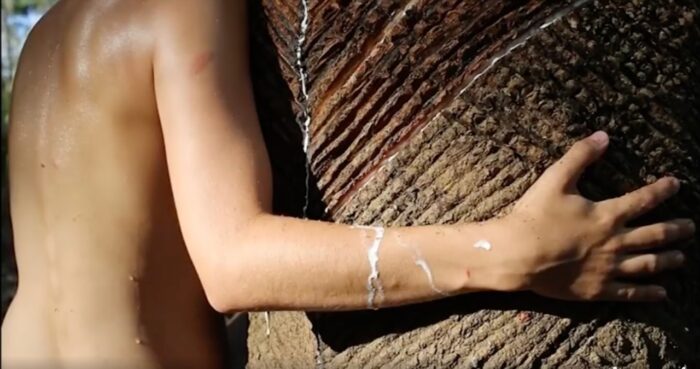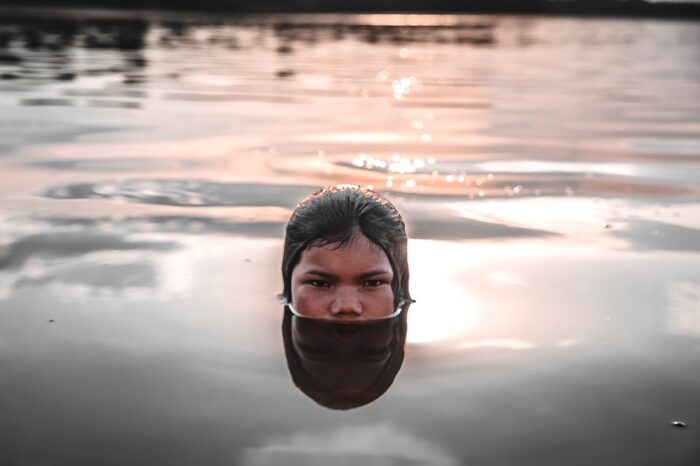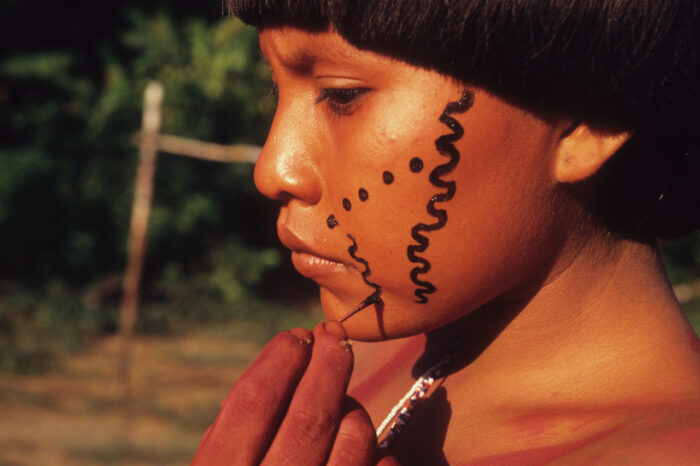
Visions from the Amazon
07 March, 2025Visions from the Amazon, the new exhibition at London’s Peltz Gallery until 9 April 2025, features photographs by Claudia Andujar alongside paintings by rubber tapper Hélio Melo; artworks and photographs by Indigenous artists Denilson Baniwa and Tayná Satere; and photographs and films by Paula Sampaio, Luciana Magno, and Nay Jinknss, who live in the Amazon’s urban areas, together with photographs by São Paulo-based Rosa Gauditano.
This article was originally published by Latin America Bureau here. Sign up to Latin America Bureau’s newsletter for similar stories.
The Amazon forest in Brazil covers 49 per cent of the country’s territory and provides a home to 22 million people, some living in large urban centres and others in isolated Indigenous settlements. The Amazon is one and many forests, marked not just by unparalleled biodiversity but also by global industry, mining, travellers, Indigenous cosmovisions, land disputes, and ecocide. Most of all it is a place where human life is sustained by close collaboration with and understanding of the forest itself.
In the past decades Claudia Andujar’s images of Indigenous communities and her work as an environmental activist have brought global attention to the region.
Stemming from the doctoral research of Patricia Bonchristiano, and developed in collaboration with Erika Zerwes and Peltz Gallery, the exhibition proposes a visual exploration of entanglements between artistic production and the living and more-than-living elements of the forest. It also advocates that, alongside the efforts of Indigenous communities, activist groups, and international organisations, environmentally engaged art has the power to redefine political discourse, reimagining the relationships between art and ecology.
Visions from the Amazon brings together artists whose work reveals the intricate relationships between human and more-than-human elements in the forest, as well as the importance that eco-activism has come to play in the region’s creative practice. The exhibition lays the focus on three main elements: the forest’s trees, water, and light and their interactions with the Indigenous and urban human presence in this dense environment.
1. Trees
Through paintings, photographs and videos, the first part of the exhibition is dedicated to artists and artworks that dialogue with trees. Trees are part of an interwoven community that interacts and shares resources through underground, often fungal, networks. The featured works of Hélio Melo, Denilson Baniwa and Luciana Magno explore how this interconnectedness extends to interactions between trees and humans, reflecting Indigenous principles of reciprocity and fostering relationships of mutual care: while trees provide sustenance, communities, in turn, nurture and protect them.

2. Water
Photographs and a video that are related with water form the second part of the exhibition. The Amazon has a vast hydrographic basin. This significant water flow is a vital force in sustaining ecosystems, transporting nutrients, purifying water, and connecting places and inhabitants. Water movement is also capable of transforming landscapes and creating meaning. The work of Paula Sampaio portrays the impact of damming on river dweller communities in Pará, a state in the eastern Amazon bordering the Atlantic Ocean to the north. Water is also a source of physical and spiritual sustenance in Tayná Satere’s images of the Sateré-Mawé Indigenous community in the frontier of the states of Amazonas and Pará.

This article is funded by readers like you
Only with regular support can we maintain our website, publish LAB books and support campaigns for social justice across Latin America. You can help by becoming a LAB Subscriber or a Friend of LAB. Or you can make a one-off donation. Click the link below to learn about the details.Support LAB
3. Light
The third and last section of the exhibition showcase photographic works that are related to light. Light is a crucial element in the photographic-making process as well as being a player in both physical/biological as much as cultural/religious processes within the forest. According to Indigenous cosmovision, light can be understood as an active element that continually interacts with and shapes the ecosystem. Nay Jinknss’s, Rosa Gauditano’s, and Claudia Andujar’s photographs engage light’s agency. This section of the exhibition comprises images taken in one of the most populated areas of the Amazon region, the city of Belém do Pará, together with artworks from Yanomami communities, which were virtually isolated until the 1940s.

Visions from the Amazon aims to offer a glimpse of how the Amazon is not a singular entity but a region of immense diversity shaped by a complex interplay of legal, hydrological, geological, and ecological boundaries,. Thus, the artists and artworks featured in this exhibition are linked to different communities and regions of the Amazon in Brazil, offering varied perspectives that reflect both the cultural vibrancy of the region and the pressing challenges it faces today.
Entry free. More details here.
The Peltz Gallery
43 Gordon Square, London WC1H 0PD
Follow Sounds and Colours: Facebook / Twitter / Instagram / Mixcloud / Soundcloud / Bandcamp
Subscribe to the Sounds and Colours Newsletter for regular updates, news and competitions bringing the best of Latin American culture direct to your Inbox.

